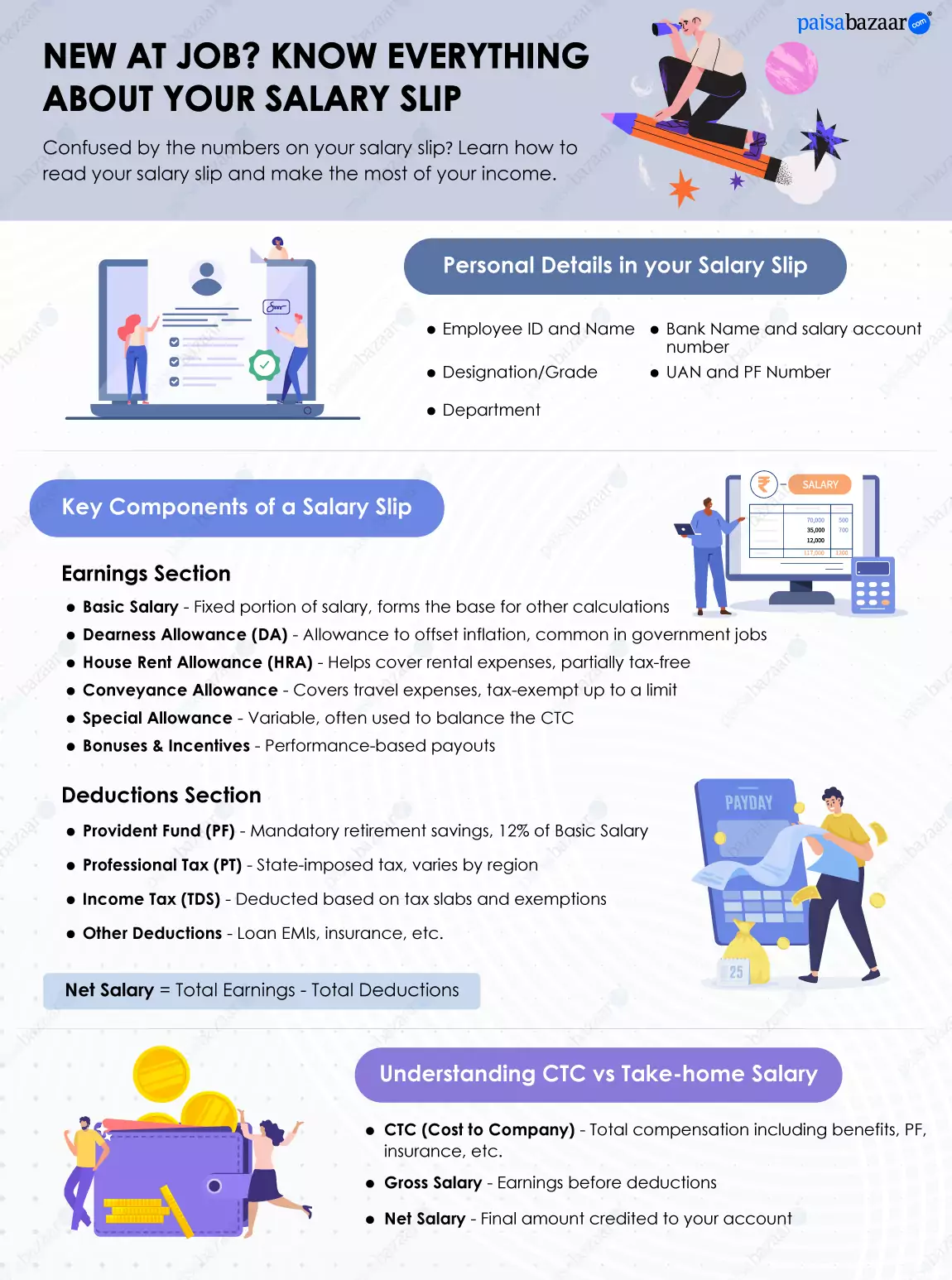

Are you new at your job and have seen your salary slip for the first time? Don’t get overwhelmed with a lot of terms and numbers in it. Read this article to understand what is covered in your salary slip and why it is important for you to know about it in detail.
What is a salary slip?
Also known as a pay slip, a salary slip is an official document issued every month to an employee by the employer. It contains the earnings and deductions of an employee, apart from a few additional details.
The salary slip is an important document that can not only be used to show your employment, but it also acts as proof of income and tax filing details.
An employee needs to provide a salary slip at the time of taking new loans or credit cards, visa application, job change, etc.
It is important to understand the components of the salary slip, as it will not only help you become aware of your salary components but also assist you in saving taxes if you subscribe to the old tax regime.
Also Read: What is Basic Salary
Components of a Salary Slip
Let’s make your salary slip easier to understand by categorizing it into three key sections: Personal Details, Earnings, and Deductions.
1. Employee’s Personal Information in the Salary Slip
This section contains an employee’s personal information and account details. Some entries in this section may vary from one employer to another. However, most employers provide the following information in this section:
- Employee ID and Name
- Designation/Grade
- Department
- Bank Name and salary account number
- ESIC Number
- UAN and PF Number
- Total Days Present/Absent
2. Earnings Section
This section contains all earnings from different heads for an employee that are provided by an employer. Various earning heads are described in detail below:
Basic Salary
- This is the fixed portion of salary that is pre-determined at the time of joining/appraisal.
- It does not contain any additional amount or deduction.
- Basic salary forms the base for other calculations such as HRA, bonuses, allowances, etc.
- It is provided to employees of both the government sector and the private sector
- Basic salary is fully taxable as per the employee’s Income slab
Dearness Allowance (DA)
- Dearness Allowance is a fixed percentage of your basic salary paid to cover the impact of rising prices or inflation.
- This is provided to central and state government employees, government pensioners and employees of some Public Sector Undertakings
- This amount is fully taxable as per the Income Tax Slab that one falls into
- DA is revised by the government based on changes in the Consumer Price Index (CPI).
House Rent Allowance (HRA)
- HRA is provided to an employee by the employer to meet rental expenses.
- It forms a part of the gross salary and is provided to salaried employees who live in rented accommodation.
- An employee can claim tax exemption on HRA under Section 10(13A) of the Income Tax Act.
- Employees can claim exemption on HRA only if they live in a rented accommodation
- To claim exemption, the least of the following is considered –
- Actual HRA received
- 50% of salary (in metro cities) / 40% (in non-metros)
- Rent paid minus 10% of the basic salary
Conveyance Allowance
- This allowance is provided to cover travel expenses to and from the office
- It can either be a fixed monthly component or reimbursement based on actual travel expenses
- Tax exemption allowed up to Rs. 1,600 monthly in the old regime, but not exempted in the new regime
Special Allowances
- It is provided to balance out the CTC after covering the major components of the salary
- No specific reason is provided for special allowances
- It is fully taxable under both tax regimes
Bonus and Incentives
- A conditional payment to employees, linked to company performance or employee’s service, made annually, semi-annually or occasionally.
- This is a variable amount and forms part of the taxable income
- The target-based payout is meant to motivate and reward employees for exceeding goals
3. Deductions Section
This section lists all deduction heads under which deductions are made from the salary of the employee.
Employees’ Provident Fund (EPF)
- It is a mandatory retirement savings scheme backed by the government
- Here, the employee and the employer contribute 12% of the basic salary + dearness allowance (max. Rs. 15,000 is considered) for EPF and EPS
- The employee’s 12% contribution is used up for EPF
- The employer’s 12% contribution is split into 8.33% for EPS and 3.67% for EPF
- Tax benefits under Section 80C of the Income Tax Act under the old tax regime
Suggested Read: Employees’ Provident Fund (EPF)
Professional Tax
- This is a state-imposed tax applicable to those providing professional services
- The rate of tax varies from one region to another
Income Tax
- It is deducted based on your tax slab and the regime you choose
- Income tax is divided into 12 equal parts, and TDS is deducted every month
- All income tax deductions are mentioned in the salary slip
Other Deductions
- Deduction components such as loan EMIs, insurance, car lease details, etc., are mentioned in this section
- ESOP tax, if deducted, is also mentioned in this section
- An employee may or may not have these deductions mentioned in the salary slip
Understanding CTC vs Take-home Salary
The salary package that you were promised at the time of joining is quite different from what you get every month in your bank account. This is because CTC is different from your take-home salary. Let us understand it in detail below:
Cost to Company (CTC)
Cost to Company or CTC is the total amount an employer spends on the employee in a year. It includes the monthly salary, benefits, bonuses, and even retirement contributions.
CTC is made up of multiple components – fixed component, variable pay, benefits and contributions, such as EPF, gratuity, health insurance, etc.
It is worth noting here that the employee’s Income Tax is not calculated on the basis of the CTC.
Gross Salary
Gross salary is the total salary of an employee calculated based on earnings throughout the year. It does not contain any deductions like taxes, provident fund (EPF), or professional tax.
Read in Detail: Gross Salary
Net Salary or Take-home Salary
Take-home salary is the actual amount credited to your bank account every month. It is calculated after adding all earnings and removing all exemptions and deductions from the CTC.
To make it understandable, your net salary is the amount that is calculated after deducting income tax from your gross salary and other deduction components.
| Net Salary = Total Earnings – Total Deductions |
Read in Detail: How is Net Salary Calculated
Why Should You Check Your Salary Slip Every Month
Your employer shares your salary slip every month. If you don’t receive it, contact HR or the concerned person in your company to get it.
It is recommended that you check your salary slip every month. It shall help you:
- Understand your salary structure and become familiar with all components of your salary
- Identify errors in deductions or calculations, if any
- Track tax liability and plan savings
- Ensure compliance with company policies
This shall help you plan your finances better and also plan investments in coming future, especially if you have subscribed for the old tax regime.
